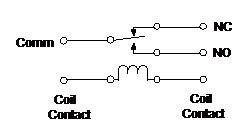Relay is a switch which senses fault in a system and once fault is sensed by the Relay, it issues trip command to the Circuit Breaker, CB to isolate the faulty section of the network from the healthy section.
The Relay detects the abnormal condition by continuously monitoring electrical quantities which are different for healthy and faulty condition. The electrical quantities which may change during fault condition are voltage, current, frequency and phase angle. If one or more of the above electrical quantities change, that signals the presence, type and location of the fault to the Relay. After detecting the fault condition, Relay pick-up, its contact will change from NO to NC or vice versa. So we can wire up a particular kind of Relay contact to Breaker tripping circuit. So whenever, the Relay picks up, the tripping of Breaker will take place.
You may like to Read, Why CT Secondary Shall Never be Kept Open?
A simplified Relay circuit is shown in figure below. Figure below shows one of the three phase system for simplicity.
As shown in the figure above, Current Transformer CT secondary winding is directly connected to the Relay coil. Under normal condition, the current through the Relay coil is not sufficient enough to pull the plunger and close the circuit of Breaker Tripping Coil. Notice here that Breaker Tripping coil is solely responsible for the tripping of Circuit Breaker. If trip coil of breaker fails, then tripping of Breaker will not take place. This is the reason, two trip coils are normally provided in Circuit Breaker to get reliable operation of Breaker. Not only two Trip Coils are provided in CB rather a Trip Coil monitoring Relay is also used. If case of fault i.e. if it happens to be any open circuit in Trip Coil, then the Trip Coil Supervision Relay will be flagged to attract the attention of the operator.
In case of fault, the current through the CT secondary will go up which will cause increased current through the Relay coil. If it happens that the current through the Relay coil exceeds the setting value or pick-up value then the coil will get produce sufficient magnetic pull to the plunger and thus plunger will complete the CB trip circuit. As soon as the CB trip circuit is complete, current will start flowing in the Trip Coil which in turn will pull a lever to trip the Circuit Breaker CB.
In the above figure, it is shown that Relay coil is directly pulling the plunger to complete the Breaker Trip Coil circuit but in actual practice, Relay coil when picked up will change its contact status. Let us say Relay Normally Open (NO) contact is wired to the Breaker Trip Coil Circuit. Therefore when the Relay coil is in de-energized state, the circuit of Trip Coil of CB is not complete and hence no tripping of the CB. During fault condition as the current through the Relay coil exceeds the pick-up value, the Relay coil will get actuated which in turn will force its contact to change over i.e. NO contact will change to Normally Close (NC) thereby closing the Trip Coil circuit of the Breaker.
Since Trip Coil circuit of Breaker is complete, current will flow through the Trip Coil causing CB to trip.


Nice Article.Relays are used to provide time delay functions. They are used to time the delay open and delay close of contacts. Relays are used to control high voltage circuits with the help of low voltage signals. Similarly, they are used to control high current circuits with the help of low current signals.